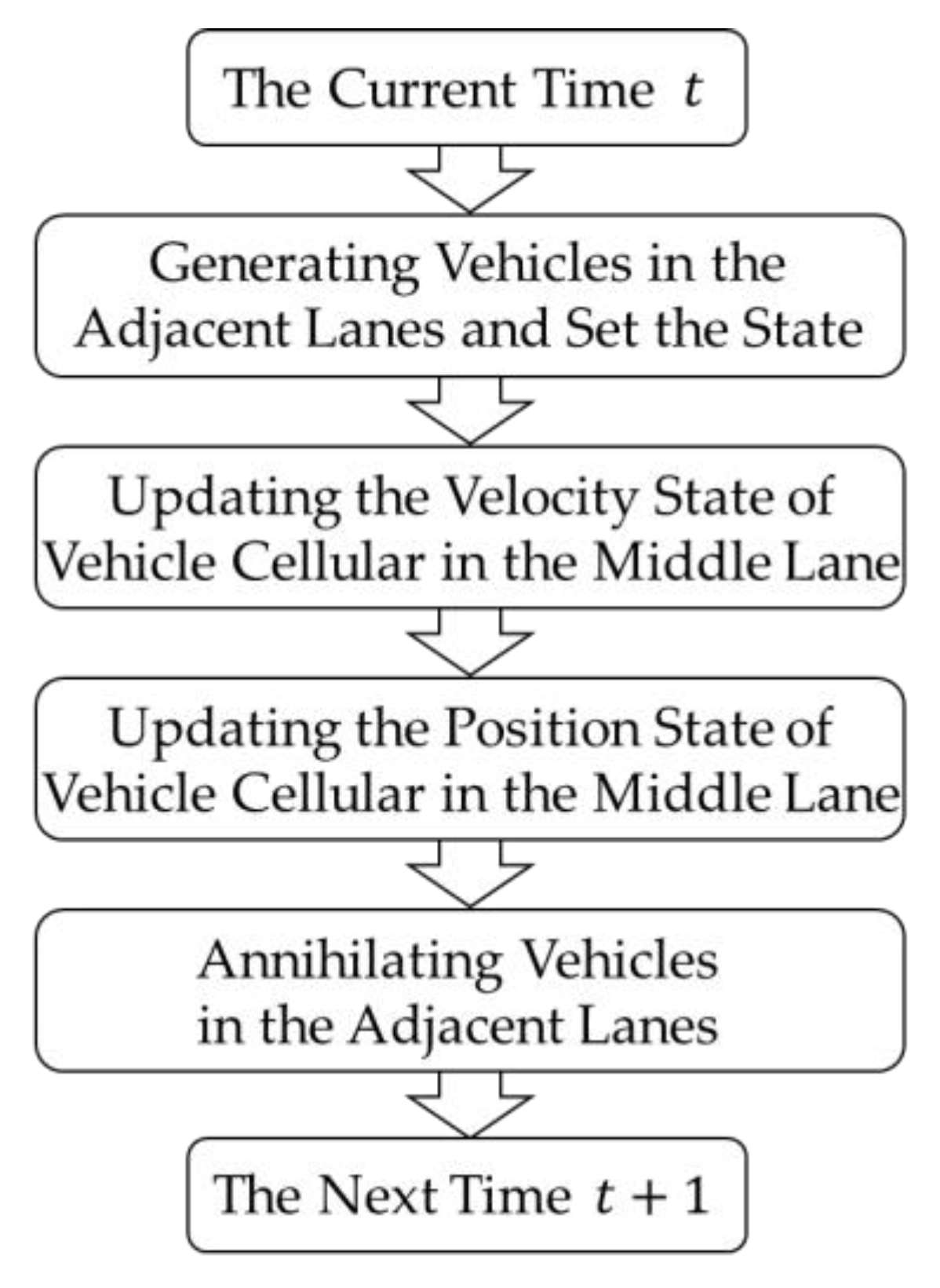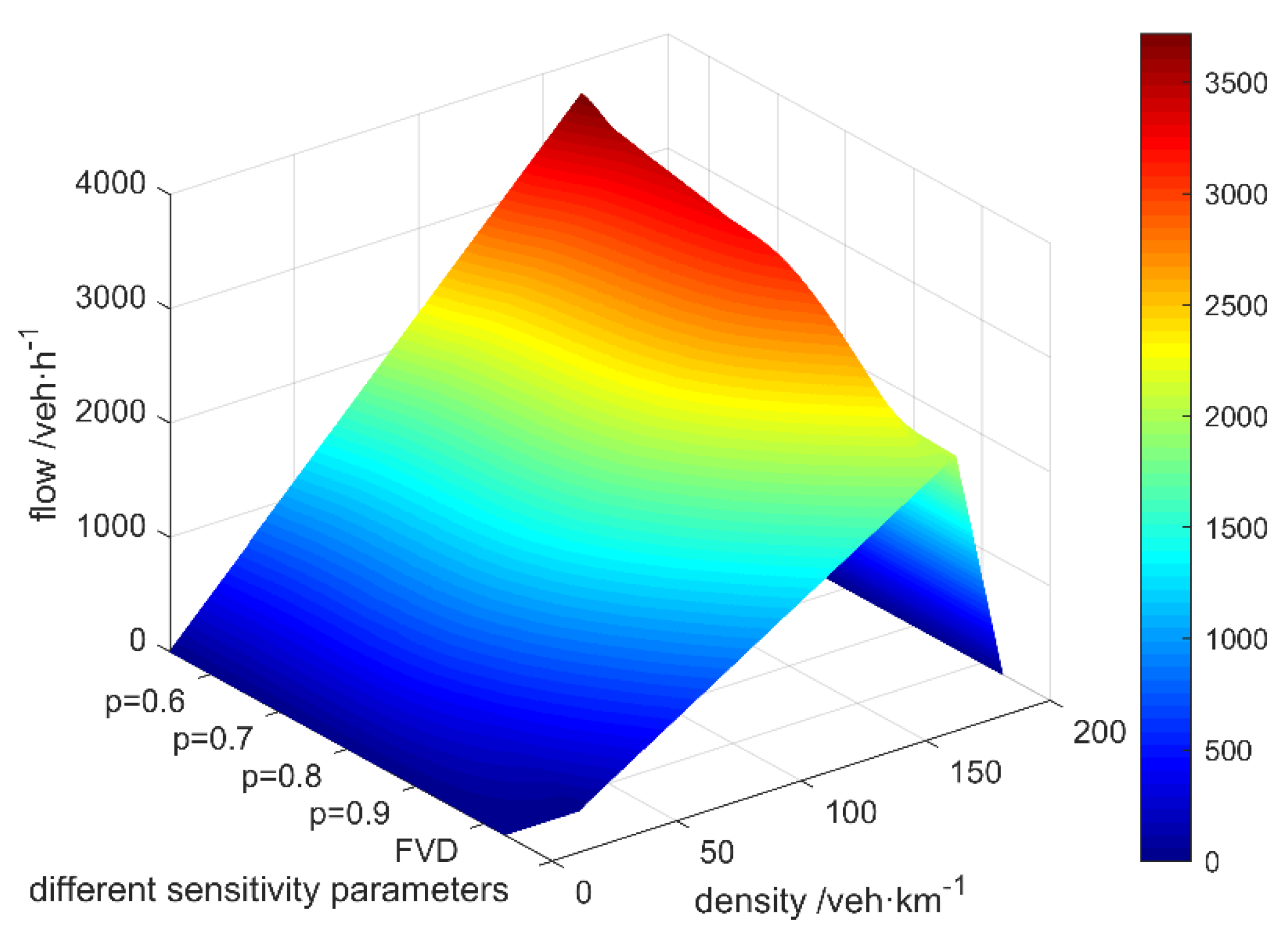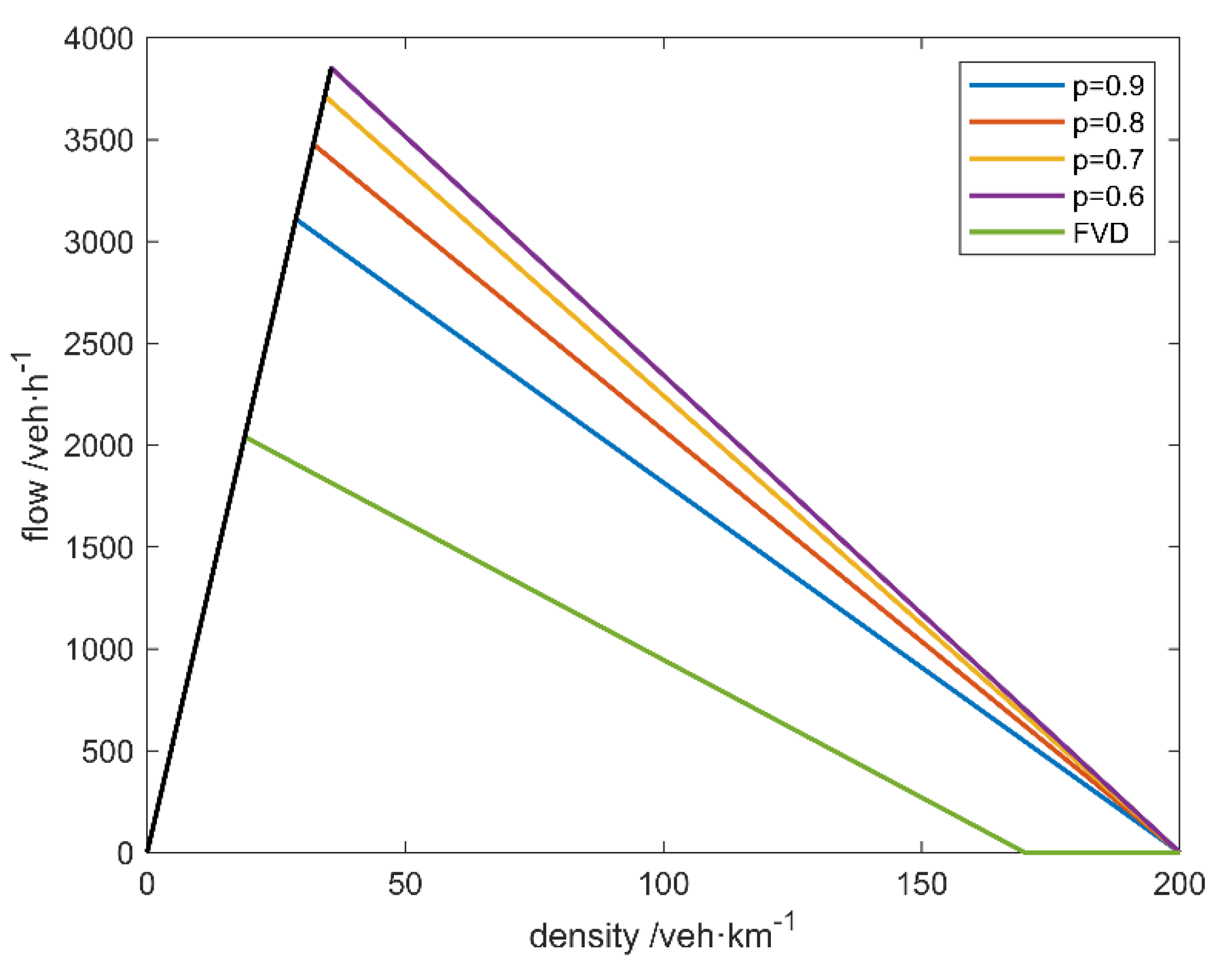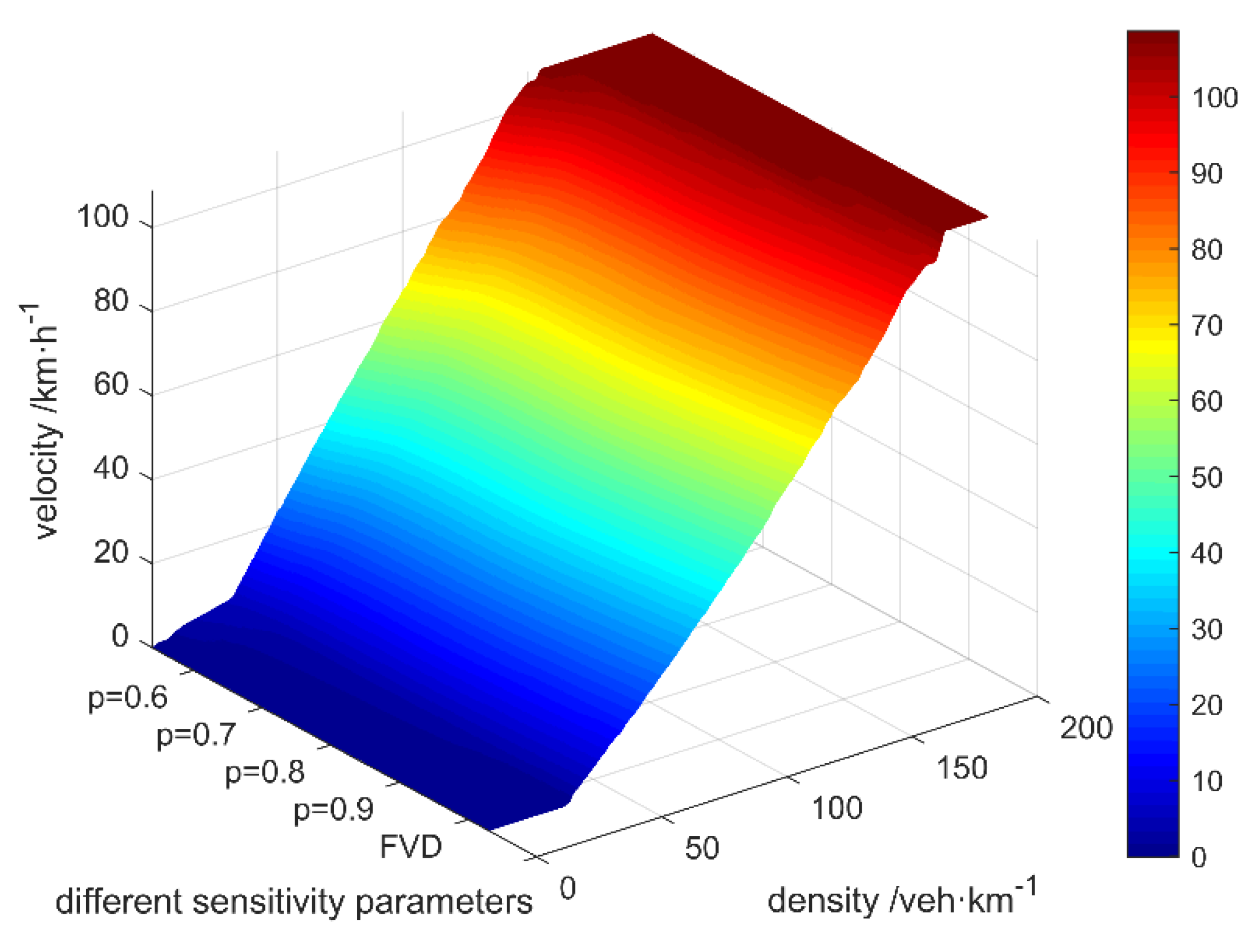Research on the Impacts of Generalized Preceding Vehicle Information on Traffic Flow in V2X Environment
Abstract
1. Introduction
2. Simulation Framework
3. Simulation
3.1. Setting of the Simulation Scenario
3.2. The Simulation of Traffic Flow
3.3. Simulation on the Impacts of Disturbance on Traffic Flow
4. Discussion
5. Conclusions
Author Contributions
Funding
Data Availability Statement
Conflicts of Interest
Appendix A
| Abbreviations | Full Name |
|---|---|
| V2X | vehicles to everything |
| GPV | generalized preceding vehicles |
| CA | cellular automata |
| OV | optimal velocity |
| GF | generalized force |
| FVD | full velocity difference |
| TFSF | traffic flow simulation framework |
| CACC | cooperative adaptive cruise control |
References
- Kuutti, S.; Fallah, S.; Katsaros, K.; Dianati, M.; Mccullough, F.; Mouzakitis, A. A Survey of the State-of-the-Art Localization Techniques and Their Potentials for Autonomous Vehicle Applications. IEEE Internet Things J. 2018, 5, 829–846. [Google Scholar] [CrossRef]
- Haider, A.; Hwang, S.H. Adaptive Transmit Power Control Algorithm for Sensing-Based Semi-Persistent Scheduling in C-V2X Mode 4 Communication. Electronics 2019, 8, 846. [Google Scholar] [CrossRef]
- Mannoni, V.; Berg, V.; Sesia, S.; Perraud, E. A Comparison of the V2X Communication Systems: ITS-G5 and C-V2X. In Proceedings of the 2019 IEEE 89th Vehicular Technology Conference (VTC2019-Spring), Kuala Lumpur, Malaysia, 28 April–1 May 2019; pp. 1–5. [Google Scholar]
- Naik, G.; Choudhury, B.; Park, J.-M. IEEE 802.11bd & 5G NR V2X: Evolution of Radio Access Technologies for V2X Communications. IEEE Access 2019, 7, 70169–70184. [Google Scholar] [CrossRef]
- Chen, S.; Hu, J.; Shi, Y.; Zhao, L.; Li, W. A Vision of C-V2X: Technologies, Field Testing, and Challenges with Chinese Development. IEEE Internet Things J. 2020, 7, 3872–3881. [Google Scholar] [CrossRef]
- Qi, W.; Landfeldt, B.; Song, Q.; Guo, L.; Jamalipour, A. Traffic Differentiated Clustering Routing in DSRC and C-V2X Hybrid Vehicular Networks. IEEE Trans. Veh. Technol. 2020, 69, 7723–7734. [Google Scholar] [CrossRef]
- Romeo, F.; Campolo, C.; Molinaro, A.; Berthet, A.O. DENM Repetitions to Enhance Reliability of the Autonomous Mode in NR V2X Sidelink. In Proceedings of the 2020 IEEE 91st Vehicular Technology Conference (VTC2020-Spring), Antwerp, Belgium, 25–28 May 2020; pp. 1–5. [Google Scholar]
- Tang, F.; Kawamot, Y.; Kato, N.; Liu, J. Future Intelligent and Secure Vehicular Network Toward 6G: Machine-Learning Approaches. Proc. IEEE 2020, 108, 292–307. [Google Scholar] [CrossRef]
- Zadobrischi, E.; Dimian, M. Vehicular Communications Utility in Road Safety Applications: A Step toward Self-Aware Intelligent Traffic Systems. Symmetry 2021, 13, 438. [Google Scholar] [CrossRef]
- Li, Y.; Wang, H.; Wang, W.; Xing, L.; Liu, S.; Wei, X. Evaluation of the Impacts of Cooperative Adaptive Cruise Control on Reducing Rear-End Collision Risks on Freeways. Accid. Anal. Prev. 2017, 98, 87–95. [Google Scholar] [CrossRef]
- Rios-Torres, J.; Malikopoulos, A.A. A Survey on the Coordination of Connected and Automated Vehicles at Intersections and Merging at Highway On-Ramps. IEEE Trans. Intell. Transp. Syst. 2017, 18, 1066–1077. [Google Scholar] [CrossRef]
- Stern, R.E.; Cui, S.; Delle Monache, M.L.; Bhadani, R.; Bunting, M.; Churchill, M.; Hamilton, N.; Haulcy, R.; Pohlmann, H.; Wu, F.; et al. Dissipation of Stop-and-Go Waves via Control of Autonomous Vehicles: Field Experiments. Transp. Res. Part C Emerg. Technol. 2018, 89, 205–221. [Google Scholar] [CrossRef]
- Papadoulis, A.; Quddus, M.; Imprialou, M. Evaluating the Safety Impact of Connected and Autonomous Vehicles on Motorways. Accid. Anal. Prev. 2019, 124, 12–22. [Google Scholar] [CrossRef]
- Ye, L.; Yamamoto, T. Evaluating the Impact of Connected and Autonomous Vehicles on Traffic Safety. Phys. Stat. Mech. ITS Appl. 2019, 526. [Google Scholar] [CrossRef]
- Zadobrischi, E.; Cosovanu, L.-M.; Dimian, M. Traffic Flow Density Model and Dynamic Traffic Congestion Model Simulation Based on Practice Case with Vehicle Network and System Traffic Intelligent Communication. Symmetry 2020, 12, 1172. [Google Scholar] [CrossRef]
- Farah, H.; Koutsopoulos, H.N. Do Cooperative Systems Make Drivers’ Car-Following Behavior Safer? Transp. Res. Part C Emerg. Technol. 2014, 41, 61–72. [Google Scholar] [CrossRef]
- Li, X.; Cui, J.; An, S.; Parsafard, M. Stop-and-Go Traffic Analysis: Theoretical Properties, Environmental Impacts and Oscillation Mitigation. Transp. Res. Part B Methodol. 2014, 70, 319–339. [Google Scholar] [CrossRef]
- Jia, D.; Ngoduy, D. Enhanced Cooperative Car-Following Traffic Model with the Combination of V2V and V2I Communication. Transp. Res. Part B Methodol. 2016, 90, 172–191. [Google Scholar] [CrossRef]
- Nagatani, T. Stabilization and Enhancement of Traffic Flow by the Next-Nearest-Neighbor Interaction. Phys. Rev. E 1999, 60, 6395–6401. [Google Scholar] [CrossRef]
- Lenz, H.; Wagner, C.K.; Sollacher, R. Multi-Anticipative Car-Following Model. Eur. Phys. J. B 1999, 7, 331–335. [Google Scholar] [CrossRef]
- Ge, H.X.; Dai, S.Q.; Dong, L.Y.; Xue, Y. Stabilization Effect of Traffic Flow in an Extended Car-Following Model Based on an Intelligent Transportation System Application. Phys. Rev. E 2004, 70, 066134. [Google Scholar] [CrossRef]
- Li, Z.-P.; Liu, Y.-C. Analysis of Stability and Density Waves of Traffic Flow Model in an ITS Environment. Eur. Phys. J. B 2006, 53, 367–374. [Google Scholar] [CrossRef]
- Peng, G.H.; Sun, D.H. A Dynamical Model of Car-Following with the Consideration of the Multiple Information of Preceding Cars. Phys. Lett. A 2010, 374, 1694–1698. [Google Scholar] [CrossRef]
- Li, Y.; Sun, D.; Liu, W.; Zhang, M.; Zhao, M.; Liao, X.; Tang, L. Erratum to: Modeling and Simulation for Microscopic Traffic Flow Based on Multiple Headway, Velocity and Acceleration Difference. Nonlinear Dyn. 2011, 66, 845. [Google Scholar] [CrossRef][Green Version]
- Hu, Y.; Ma, T.; Chen, J. An Extended Multi-Anticipative Delay Model of Traffic Flow. Commun. Nonlinear Sci. Numer. Simul. 2014, 19, 3128–3135. [Google Scholar] [CrossRef]
- Chen, J.; Liu, R.; Ngoduy, D.; Shi, Z. A New Multi-Anticipative Car-Following Model with Consideration of the Desired Following Distance. Nonlinear Dyn. 2016, 85, 2705–2717. [Google Scholar] [CrossRef]
- Guo, L.; Zhao, X.; Yu, S.; Li, X.; Shi, Z. An Improved Car-Following Model with Multiple Preceding Cars’ Velocity Fluctuation Feedback. Phys. Stat. Mech. Its Appl. 2017, 471, 436–444. [Google Scholar] [CrossRef]
- Sun, D.; Kang, Y.; Yang, S. A Novel Car Following Model Considering Average Speed of Preceding Vehicles Group. Phys. Stat. Mech. Its Appl. 2015, 436, 103–109. [Google Scholar] [CrossRef]
- Kuang, H.; Xu, Z.-P.; Li, X.-L.; Lo, S.-M. An Extended Car-Following Model Accounting for the Average Headway Effect in Intelligent Transportation System. Phys. Stat. Mech. Its Appl. 2017, 471, 778–787. [Google Scholar] [CrossRef]
- Guo, Y.; Xue, Y.; Shi, Y.; Wei, F.; Lü, L.; He, H. Mean-Field Velocity Difference Model Considering the Average Effect of Multi-Vehicle Interaction. Commun. Nonlinear Sci. Numer. Simul. 2018, 59, 553–564. [Google Scholar] [CrossRef]
- Wen-Xing, Z.; Li-Dong, Z. A New Car-Following Model for Autonomous Vehicles Flow with Mean Expected Velocity Field. Phys. Stat. Mech. Its Appl. 2018, 492, 2154–2165. [Google Scholar] [CrossRef]
- Kuang, H.; Wang, M.-T.; Lu, F.-H.; Bai, K.-Z.; Li, X.-L. An Extended Car-Following Model Considering Multi-Anticipative Average Velocity Effect under V2V Environment. Phys. Stat. Mech. Its Appl. 2019, 527, 121268. [Google Scholar] [CrossRef]
- Han, J.; Zhang, J.; Wang, X.; Liu, Y.; Wang, Q.; Zhong, F. An Extended Car-Following Model Considering Generalized Preceding Vehicles in V2X Environment. Future Internet 2020, 12, 216. [Google Scholar] [CrossRef]
- Bando, M.; Hasebe, K.; Nakayama, A.; Shibata, A.; Sugiyama, Y. Dynamical Model of Traffic Congestion and Numerical Simulation. Phys. Rev. E 1995, 51, 1035–1042. [Google Scholar] [CrossRef] [PubMed]
- Helbing, D.; Tilch, B. Generalized Force Model of Traffic Dynamics. Phys. Rev. E 1998, 58, 133–138. [Google Scholar] [CrossRef]
- Treiber, M.; Hennecke, A.; Helbing, D. Derivation, Properties, and Simulation of a Gas-Kinetic-Based, Nonlocal Traffic Model. Phys. Rev. E 1999, 59, 239–253. [Google Scholar] [CrossRef]
- Jiang, R.; Wu, Q.; Zhu, Z. Full Velocity Difference Model for a Car-Following Theory. Phys. Rev. E 2001, 64, 017101. [Google Scholar] [CrossRef]
- Yi, J.; Horowitz, R. Macroscopic Traffic Flow Propagation Stability for Adaptive Cruise Controlled Vehicles. Transp. Res. Part C Emerg. Technol. 2006, 14, 81–95. [Google Scholar] [CrossRef]
- Ngoduy, D. Application of Gas-Kinetic Theory to Modelling Mixed Traffic of Manual and ACC Vehicles. Transportmetrica 2012, 8, 43–60. [Google Scholar] [CrossRef]
- Ngoduy, D. Instability of Cooperative Adaptive Cruise Control Traffic Flow: A Macroscopic Approach. Commun. Nonlinear Sci. Numer. Simul. 2013, 18, 2838–2851. [Google Scholar] [CrossRef]
- Ngoduy, D. Platoon-Based Macroscopic Model for Intelligent Traffic Flow. Transp. B Transp. Dyn. 2013, 1, 153–169. [Google Scholar] [CrossRef]
- Ngoduy, D.; Jia, D. Multi Anticipative Bidirectional Macroscopic Traffic Model Considering Cooperative Driving Strategy. Transp. B Transp. Dyn. 2017, 5, 96–110. [Google Scholar] [CrossRef]
- Delis, A.I.; Nikolos, I.K.; Papageorgiou, M. A Macroscopic Multi-Lane Traffic Flow Model for ACC/CACC Traffic Dynamics. Transp. Res. Rec. 2018, 2672, 178–192. [Google Scholar] [CrossRef]
- Wolfram, S. Statistical Mechanics of Cellular Automata. Rev. Mod. Phys. 1983, 55, 601–644. [Google Scholar] [CrossRef]
- Cremer, M.; Ludwig, J. A Fast Simulation Model for Traffic Flow on the Basis of Boolean Operations. Math. Comput. Simul. 1986, 28, 297–303. [Google Scholar] [CrossRef]
- Nagel, K.; Schreckenberg, M. A Cellular Automaton Model for Freeway Traffic. J. Phys. I 1992, 2, 2221–2229. [Google Scholar] [CrossRef]
- Biham, O.; Middleton, A.A.; Levine, D. Self-Organization and a Dynamical Transition in Traffic-Flow Models. Phys. Rev. A 1992, 46, R6124–R6127. [Google Scholar] [CrossRef] [PubMed]
- Takayasu, M.; Takayasu, H. 1/f noise in a traffic model. Fractals 1993, 1, 860–866. [Google Scholar] [CrossRef]
- Nagatani, T. Self-Organization and Phase Transition in Traffic-Flow Model of a Two-Lane Roadway. J. Phys. Math. Gen. 1993, 26, L781–L787. [Google Scholar] [CrossRef]
- Fukui, M.; Ishibashi, Y. Traffic Flow in 1D Cellular Automaton Model Including Cars Moving with High Speed. J. Phys. Soc. Jpn. 1996, 65, 1868–1870. [Google Scholar] [CrossRef]
- Rickert, M.; Nagel, K.; Schreckenberg, M.; Latour, A. Two Lane Traffic Simulations Using Cellular Automata. Phys. Stat. Mech. Its Appl. 1996, 231, 534–550. [Google Scholar] [CrossRef]
- Knospe, W.; Santen, L.; Schadschneider, A.; Schreckenberg, M. Towards a Realistic Microscopic Description of Highway Traffic. J. Phys. Math. Gen. 2000, 33, L477. [Google Scholar] [CrossRef]
- Pedersen, M.; Ruhoff, P.T. Entry Ramps in the Nagel-Schreckenberg Model. Phys. Rev. E Stat. Nonlin. Soft Matter Phys. 2002, 65, 056705. [Google Scholar] [CrossRef]
- Bham, G.H.; Benekohal, R.F. A High Fidelity Traffic Simulation Model Based on Cellular Automata and Car-Following Concepts. Transp. Res. Part C Emerg. Technol. 2004, 12, 1–32. [Google Scholar] [CrossRef]
- He, Y.; Yao, D.; Zhang, Y.; Pei, X.; Li, L. Cellular Automaton Model for Bidirectional Traffic under Condition of Intelligent Vehicle Infrastructure Cooperative Systems. In Proceedings of the 2016 IEEE International Conference on Vehicular Electronics and Safety (ICVES), Beijing, China, 10–12 July 2016; pp. 1–6. [Google Scholar]
- Darwish, S.M. Empowering Vehicle Tracking in a Cluttered Environment with Adaptive Cellular Automata Suitable to Intelligent Transportation Systems. IET Intell. Transp. Syst. 2017, 11, 84–91. [Google Scholar] [CrossRef]
- Xue, S.; Jia, B.; Jiang, R.; Li, X.; Shan, J. An Improved Burgers Cellular Automaton Model for Bicycle Flow. Phys. Stat. Mech. Its Appl. 2017, 487, 164–177. [Google Scholar] [CrossRef]
- Pang, M.-B.; Ren, B.-N. Effects of Rainy Weather on Traffic Accidents of a Freeway Using Cellular Automata Model. Chin. Phys. B 2017, 26, 108901. [Google Scholar] [CrossRef]
- Mu, R.; Yamamoto, T. Analysis of Traffic Flow with Micro-Cars with Respect to Safety and Environmental Impact. Transp. Res. Part Policy Pract. 2019, 124, 217–241. [Google Scholar] [CrossRef]
- Yeldan, Ö.; Colorni, A.; Luè, A.; Rodaro, E. A Stochastic Continuous Cellular Automata Traffic Flow Model with a Multi-Agent Fuzzy System. Procedia Soc. Behav. Sci. 2012, 54, 1350–1359. [Google Scholar] [CrossRef]
- Zamith, M.; Leal-Toledo, R.C.P.; Clua, E.; Toledo, E.M.; de Magalhães, G.V.P. A New Stochastic Cellular Automata Model for Traffic Flow Simulation with Drivers’ Behavior Prediction. J. Comput. Sci. 2015, 9, 51–56. [Google Scholar] [CrossRef]
- Li, X.; Li, X.; Xiao, Y.; Jia, B. Modeling Mechanical Restriction Differences between Car and Heavy Truck in Two-Lane Cellular Automata Traffic Flow Model. Phys. Stat. Mech. Its Appl. 2016, 451, 49–62. [Google Scholar] [CrossRef]
- Heeroo, K.N.S.; Gukhool, O.; Hoorpah, D. A Ludo Cellular Automata Model for Microscopic Traffic Flow. J. Comput. Sci. 2016, 16, 114–127. [Google Scholar] [CrossRef]
- Qian, Y.-S.; Feng, X.; Zeng, J.-W. A Cellular Automata Traffic Flow Model for Three-Phase Theory. Phys. Stat. Mech. Its Appl. 2017, 479, 509–526. [Google Scholar] [CrossRef]
- Yan, F.; Pan, P.-Z.; Feng, X.-T.; Lv, J.-H.; Li, S.-J. An Adaptive Cellular Updating Scheme for the Continuous–Discontinuous Cellular Automaton Method. Appl. Math. Model. 2017, 46, 1–15. [Google Scholar] [CrossRef]
- Kesting, A.; Treiber, M. Calibrating Car-Following Models by Using Trajectory Data: Methodological Study. Transp. Res. Rec. 2008, 2088, 148–156. [Google Scholar] [CrossRef]
- Levin, M.W.; Boyles, S.D. A Cell Transmission Model for Dynamic Lane Reversal with Autonomous Vehicles. Transp. Res. Part C Emerg. Technol. 2016, 68, 126–143. [Google Scholar] [CrossRef]
- Levin, M.W.; Boyles, S.D. A Multiclass Cell Transmission Model for Shared Human and Autonomous Vehicle Roads. Transp. Res. Part C Emerg. Technol. 2016, 62, 103–116. [Google Scholar] [CrossRef]
- Tiaprasert, K.; Zhang, Y.; Aswakul, C.; Jiao, J.; Ye, X. Closed-Form Multiclass Cell Transmission Model Enhanced with Overtaking, Lane-Changing, and First-in First-out Properties. Transp. Res. Part C Emerg. Technol. 2017, 85, 86–110. [Google Scholar] [CrossRef]
- van Arem, B.; van Driel, C.J.G.; Visser, R. The Impact of Cooperative Adaptive Cruise Control on Traffic-Flow Characteristics. IEEE Trans. Intell. Transp. Syst. 2006, 7, 429–436. [Google Scholar] [CrossRef]
- Ngoduy, D.; Hoogendoorn, S.P.; Liu, R. Continuum Modeling of Cooperative Traffic Flow Dynamics. Phys. Stat. Mech. Its Appl. 2009, 388, 2705–2716. [Google Scholar] [CrossRef]
- Saffarian, M.; Happee, R. Supporting Drivers in Car Following: A Step towards Cooperative Driving. In Proceedings of the 2011 IEEE Intelligent Vehicles Symposium (IV), Baden-Baden, Germany, 5–9 June 2011; pp. 939–944. [Google Scholar]
- Milanés, V.; Shladover, S.E. Modeling Cooperative and Autonomous Adaptive Cruise Control Dynamic Responses Using Experimental Data. Transp. Res. Part C Emerg. Technol. 2014, 48, 285–300. [Google Scholar] [CrossRef]
- Liu, H.; Kan, X.D.; Shladover, S.E.; Lu, X.-Y.; Ferlis, R.E. Modeling Impacts of Cooperative Adaptive Cruise Control on Mixed Traffic Flow in Multi-Lane Freeway Facilities. Transp. Res. Part C Emerg. Technol. 2018, 95, 261–279. [Google Scholar] [CrossRef]










| Parameters | V1 | V2 | C1 | C2 | lc |
|---|---|---|---|---|---|
| 6.75 | 7.91 | 0.13 | 1.57 | 5 |
| Parameters | Generalized Preceding Vehicles (GPV) Model | Full Velocity Difference (FVD) Model |
|---|---|---|
| α | 0.767 | 0.852 |
| λ | 0.301 | 0.389 |
| p | 0.769 | -- |
| Maximum Volume | Rate A of the Increase | Rate B of the Increase | |
|---|---|---|---|
| 0.9 | veh∙h−1 | 52.40% | 0% |
| 0.8 | veh∙h−1 | 70.39% | 11.80% |
| 0.7 | veh∙h−1 | 82.03% | 6.83% |
| 0.6 | veh∙h−1 | 88.73% | 3.68% |
| Breaking Value | Rate A of the Increase | Rate B of the Increase | |
|---|---|---|---|
| 0.9 | veh/km | 52.30% | 0% |
| 0.8 | veh/km | 70.28% | 34.37% |
| 0.7 | veh/km | 81.91% | 16.55% |
| 0.6 | veh/km | 88.63% | 8.20% |
Publisher’s Note: MDPI stays neutral with regard to jurisdictional claims in published maps and institutional affiliations. |
© 2021 by the authors. Licensee MDPI, Basel, Switzerland. This article is an open access article distributed under the terms and conditions of the Creative Commons Attribution (CC BY) license (https://creativecommons.org/licenses/by/4.0/).
Share and Cite
Wang, X.; Han, J.; Bai, C.; Shi, H.; Zhang, J.; Wang, G. Research on the Impacts of Generalized Preceding Vehicle Information on Traffic Flow in V2X Environment. Future Internet 2021, 13, 88. https://doi.org/10.3390/fi13040088
Wang X, Han J, Bai C, Shi H, Zhang J, Wang G. Research on the Impacts of Generalized Preceding Vehicle Information on Traffic Flow in V2X Environment. Future Internet. 2021; 13(4):88. https://doi.org/10.3390/fi13040088
Chicago/Turabian StyleWang, Xiaoyuan, Junyan Han, Chenglin Bai, Huili Shi, Jinglei Zhang, and Gang Wang. 2021. "Research on the Impacts of Generalized Preceding Vehicle Information on Traffic Flow in V2X Environment" Future Internet 13, no. 4: 88. https://doi.org/10.3390/fi13040088
APA StyleWang, X., Han, J., Bai, C., Shi, H., Zhang, J., & Wang, G. (2021). Research on the Impacts of Generalized Preceding Vehicle Information on Traffic Flow in V2X Environment. Future Internet, 13(4), 88. https://doi.org/10.3390/fi13040088







